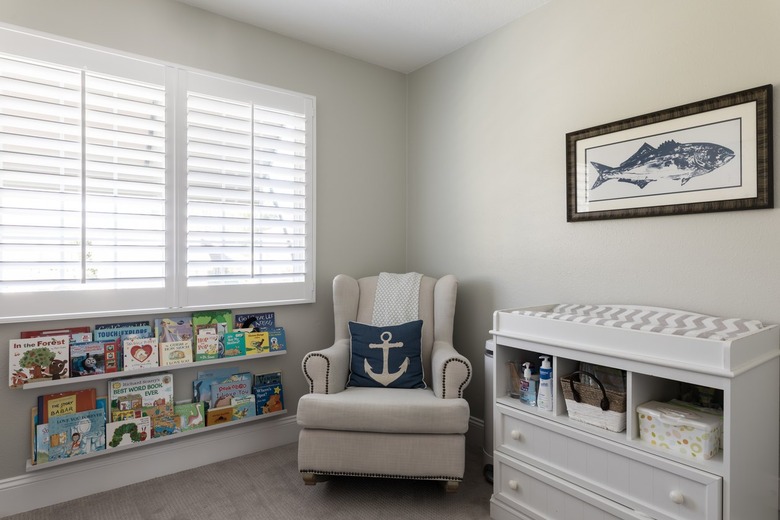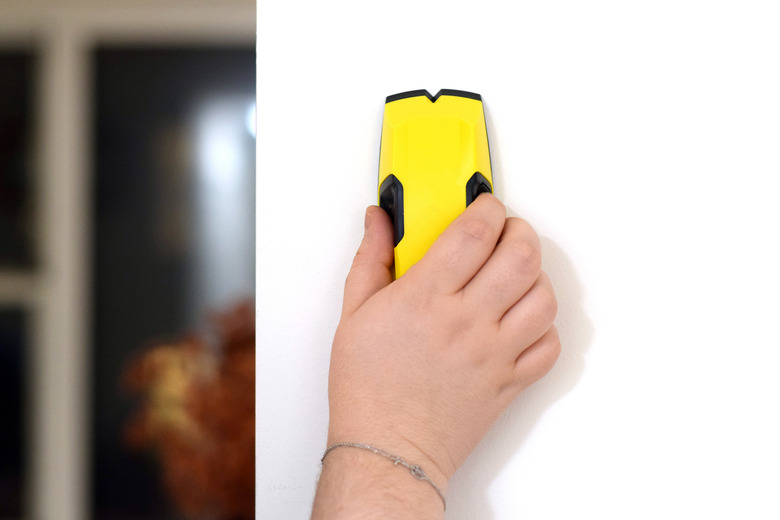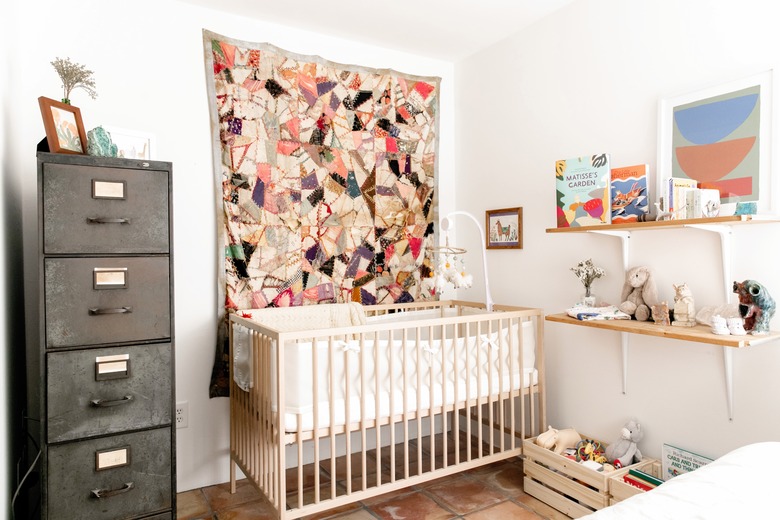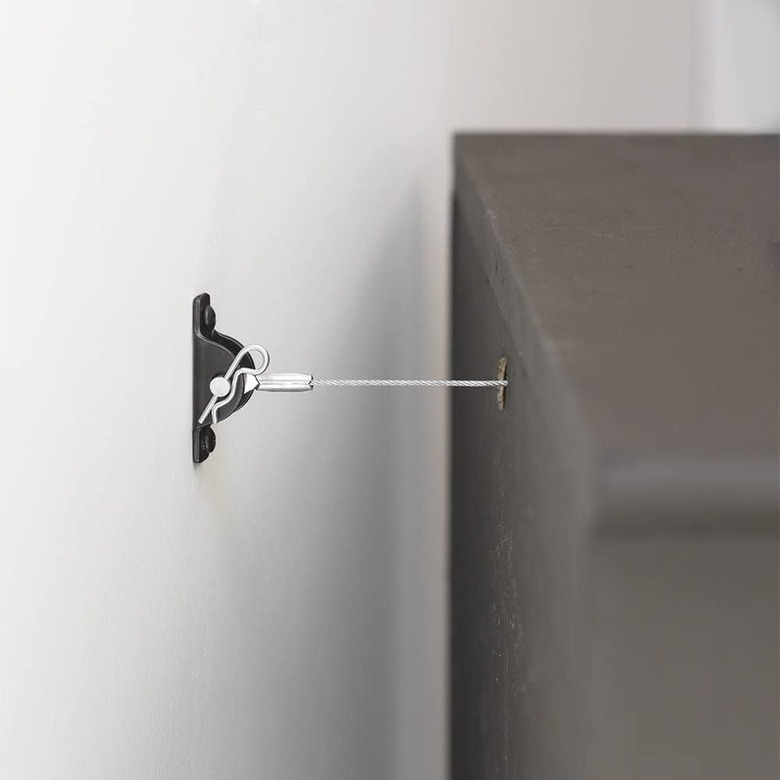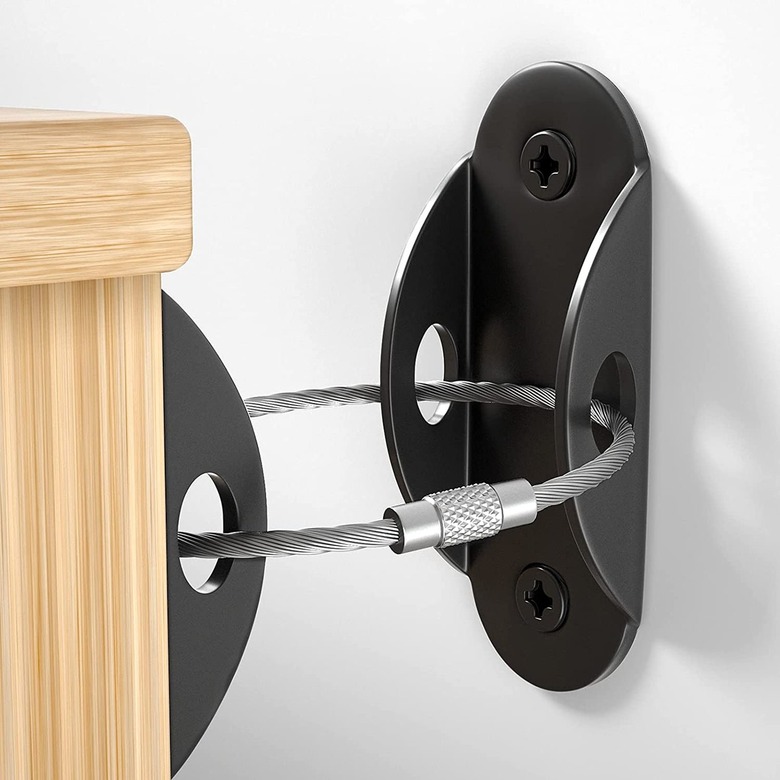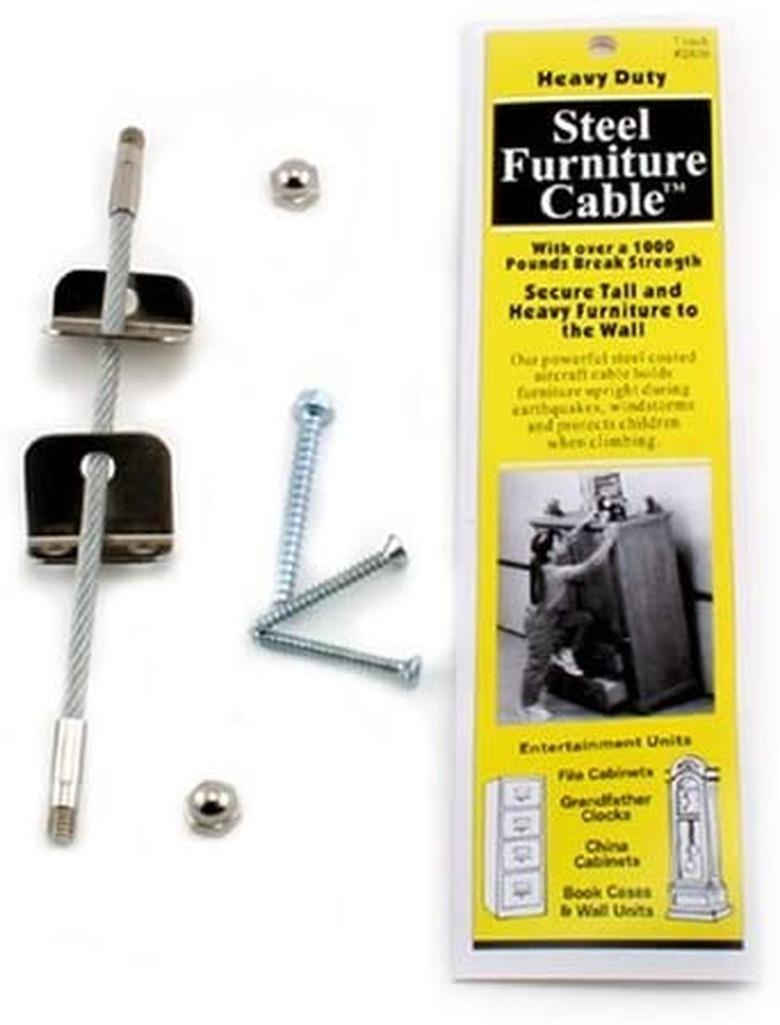How To Anchor Furniture To A Wall To Prevent Tip-Over Accidents
We may receive a commission on purchases made from links.
Having a new baby in your home is wonderful — the cooing, the cuddles, the sweet little toys scattered throughout your spaces. But then there's also something else to think about — while your baby might not even be able to walk yet, now is the time to learn how to anchor furniture to prevent tipping accidents. To anchor furniture, you'll need something called an anchoring or an anti tip-over kit.
Babyproofing your furniture will absolutely level up the safety throughout your home for your child. As the Washington Post reported late last year, astoundingly, every 46 minutes, a child in the United States goes to the emergency room after a piece of furniture has fallen on them. Blame the high-up cookie jar on the shelf, blame boredom, but eventually, kids get tempted to crawl up on or climb furniture.
We asked child safety experts to share their knowledge and best tips on anchoring furniture in your home, so you can breathe a sigh of relief knowing that your spaces will be much safer.
Why You Should Anchor
Why You Should Anchor
So, why should you anchor your furniture if you have a baby or toddler? It's simple — safety.
Patricia Bowling, Vice President of Communications for the American Home Furnishings Alliance, says that the U.S. Consumer Product Safety Commission (CPSC) has been tracking injuries and fatalities due to furniture, television, and appliance tip-overs for more than 20 years.
"Since 2000, there have been 581 tip-over-related fatalities," she says. "What parents need to know is that 81% of those were children, and, among children, 89% of the victims were under 5 years of age."
Bowling adds that when you look at those specific accidents, the majority of them involved furniture, televisions, or furniture in combination with a television. "Further, we find that the type of furniture involved in these accidents — with or without a TV — is most often a chest or dresser with drawers, and, in most cases, the child was attempting to climb the furniture," she says.
Straightforwardly, Bowling comments that furniture and television anchors can prevent fatalities. Plus, it helps that these anchors are oftentimes inexpensive and easy to install.
"The most common reason parents give for not anchoring is the belief that their child won't climb and/or if they did, the parent would be watching and able to prevent the accident," Bowling says. But this is not always the case. As Bowling notes, these accidents can happen in the blink of an eye, sometimes even when a parent or caregiver is in the room.
"Most often, it seems that [these accidents] happen in the early morning hours or during naptime, when parents are unaware a toddler has awakened and is out of bed exploring," Bowling says.
What You Should Anchor
What You Should Anchor
Though most of the available safety information on anchoring tends to focus on tall and heavy furniture, even pieces that are short and lightweight deserve your attention because they can tip when a child is climbing. Debbie Stogel, owner of Be Safe Baby Proofers in Los Angeles and member of the International Association for Child Safety, says, "There used to be some misinformation that if [the furniture] was wider than it was taller it doesn't need to be strapped, but every single piece of furniture should be strapped and secured regardless of the size."
Any furniture pieces with drawers or shelves are a must for anchoring since they make it easier to climb, Stogel says. Knobs can aid in climbing as well.
Though you shouldn't be overlooking any piece of furniture in your home to be secured and strapped via anchor, Stogel suggests you definitely shouldn't skip over the following:
- Bookcases
- Dressers (both in the child's bedroom and in all other bedrooms in the home)
- Tall pieces of furniture like an armoire or a curio cabinet
- Televisions
Tips for Anchoring Furniture Securely
Tips for Anchoring Furniture Securely
Installing anchors typically takes just a few minutes, and all anchor products should come with detailed installation instructions. But it's important to keep in mind that an anchor is only as strong as the support structure it's anchored to. Securing an anchor with screws driven directly into drywall or plaster means the anchor will not meet its specified weight rating — not even close. You need to anchor into wall studs or use heavy-duty wall anchors to secure screws to the wall.
Here are a few more tips for getting the most from your furniture anchors:
- Use a stud finder to locate wall studs directly behind the piece of furniture you're anchoring. Mark both side edges of the each stud so you can drive a screw into the stud's center for maximum strength.
- Try to anchor each piece of furniture into at least one stud, and preferably more.
- Use a heavy-duty hollow-wall anchor to secure each screw not driven into a stud.
- Make sure wall anchors are designed to resist pull-out; good examples include toggle bolts (most heavy-duty) and screw-in drywall anchors (less heavy-duty). Do not use plastic cone anchors, which offer almost no pull-out resistance.
- Ensure that screws are long enough to penetrate 1 1/2 inches or more into studs. If the wall has drywall (typically 1/2 inch thick), that means a 2-inch screw; for plaster (up to 1 inch or more in thickness), that means a 3-inch screw.
- Anchor to the strongest part of the furniture. The sides and top of a bookshelf case are solid material and relatively strong. The back may be a thin panel material that is not strong enough to hold screws.
- Drill pilot holes in furniture to prevent splitting the wood, but make sure they aren't too big. You want the screws to bite into the wood and not go in too easily.
When to Anchor Your Furniture
When to Anchor Your Furniture
It's only natural to think that you can wait to babyproof and anchor furniture until your baby is mobile. But, as Bowling says, "Let's face it — once they're mobile, it's a race to keep up." That means you're better off anchoring furniture when your baby is a newborn, or even before that.
However, if you've already had your baby and are just starting to think about babyproofing, the official recommendation is to have everything in place by the time an infant is six months old — and it can be beneficial way beyond the toddling, getting-into-everything years.
Bowling advises including furniture and television anchors on your baby registry. And be aware that general babyproofing kits often don't include furniture anchors.
"All major brands of baby safety products omit furniture and TV anchors from their home safety kits," she says. "The box may say, 'Whole Home Safety Kit,' or 'Safety Essentials Kit,' but it will not include TV or furniture tip restraints. Therefore, parents who are very safety conscious may not have even heard of a furniture anchor."
That's why you'll likely need to purchase anchoring products separately.
"Parents should purchase furniture and TV anchors at the same time they purchase other home safety devices," Bowling says. "Anchoring your furniture should be as commonplace as covering electrical outlets and securing cabinets."
The Best Furniture Anchoring Products
The Best Furniture Anchoring Products
There are hundreds of anchor products available on the market, but the official recommendation from certified babyproofers like Stogel is to use anchoring kits that have a metal connection (versus a plastic one) to both the wall and the piece of furniture. "The reason why it's needed is that it will not wear out or get weathered. It's not going to get tired over time," Stogel says.
A standard metal L-bracket can also be used to secure a tall piece, like a bookshelf, but the only downside is that you can't disconnect the bracket without removing its screws. By contrast, furniture anchors typically can be disconnected so you can easily get behind the piece of furniture or move it temporarily, then reconnect the anchor when you're done. However, L-brackets are very secure if properly installed, and you can't beat the price.
This anti-tip kit features a steel cable and metal brackets that, when properly installed, can hold up to 400 pounds. The product is tamper-proof, meaning that little curious hands can't easily finagle and dismantle it, which will set your mind at ease.
Booda Brand Furniture Anchors, 10-pack for $14.99
This anchor kit made with high-quality metal brackets and anti-break steel wires can hold up to 400 pounds when properly installed. The package comes with 10 anchors, and the official recommendation from the company is to use two anchors per piece of furniture.
Quakehold! 2830 Furniture Cable, 7-Inch (2 Pack), $10.99
This Quakehold steel furniture cable anchoring kit can secure tall and heavy furniture (up to 1,000 pounds), which is especially comforting for those who live in earthquake-prone areas. This product contains metal brackets, which attach to steel cables for extra strong tipping resistance.
